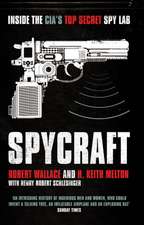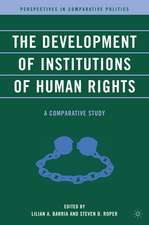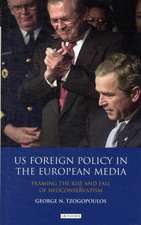Nuclear Risk Reduction in South Asia
Autor Michael Kreponen Limba Engleză Paperback – 24 noi 2004
Preț: 386.99 lei
Nou
Puncte Express: 580
Preț estimativ în valută:
74.06€ • 80.42$ • 62.21£
74.06€ • 80.42$ • 62.21£
Carte tipărită la comandă
Livrare economică 22 aprilie-06 mai
Preluare comenzi: 021 569.72.76
Specificații
ISBN-13: 9781349529865
ISBN-10: 1349529869
Pagini: 278
Ilustrații: VII, 278 p. 2 illus.
Dimensiuni: 152 x 229 x 15 mm
Greutate: 0.39 kg
Ediția:Softcover reprint of the original 1st ed. 2004
Editura: Palgrave Macmillan US
Colecția Palgrave Macmillan
Locul publicării:New York, United States
ISBN-10: 1349529869
Pagini: 278
Ilustrații: VII, 278 p. 2 illus.
Dimensiuni: 152 x 229 x 15 mm
Greutate: 0.39 kg
Ediția:Softcover reprint of the original 1st ed. 2004
Editura: Palgrave Macmillan US
Colecția Palgrave Macmillan
Locul publicării:New York, United States
Cuprins
Preface; E.Laipson Introduction; M.Krepon PART ONE: REDUCING NUCLEAR DANGERS Is Cold War Experience Applicable to Southern Asia?; M.Krepon Nuclear Restraint, Risk Reduction and the Security-Insecurity Paradox in South Asia; P.R.Chari Nuclear Risk Reducation in South Asia: Building on Common Ground; C.Gagne PART TWO: AVOIDING THE NUCLEAR THRESHOLD Missiles and Nuclear Risk-Reduction Measures; W.P.S.Sidhu Missile Threat Reduction and Monitoring; K.L.Biringer Nuclear Risk Reduction and Cooperative Aerial Observation; J.H.Hawes & T.C.Schaffer Risk Reduction in Measures in Kashmir; B.Cloughley Nuclear Risk Reduction Centers; R.uz Zaman Khan PART THREE: MISSILE DEFENSE AND REGIONAL SECURITY Missile Defense: An Indian Perspective; R.Basrur Missile Defense: Pakistanni Perspective; M.Ahmed Missile Defense and Strategic Modernization in Southern Asia; A.Kumar The Challenges of Nuclear Minimalism; W.L.Prabhakar Missile Defense and the Asian Cascade; M.Krepon
Recenzii
"If ever a region needed innovative measures to reduce nuclear risks, it is South Asia - the world's most volatile nuclear powder keg, according to many. This Stimson Center volume provides the most accessible, expert, and realistic guide to what can and should be done to stabilize the Indo-Pak nuclear relationship."
- George Perkovich, Vice President, The Carnegie Endowment for International Peace and author, India's Nuclear Bomb
"Anyone interested in the mechanics of reducing the danger of nuclear conflict in South Asia must read this book. At a time when India and Pakistan are feeling their way toward detente and China is playing a constructive regional role, the analyses in the Stimson Center's penetrating compendium of essays will enrich negotiators and policy thinkers alike. What lessons from the Cold War may be applied in South Asia remain to be worked out, but this timely volume provides an invaluable data base for choice."
- Nicholas Platt, President, The Asia Society and former U.S. Ambassador to Pakistan
"Michael Krepon's work is timely and valuable. No scholar has thought harder or more incisively about nuclear India and Pakistan than has Mr. Krepon; nor has anyone given clearer or more original thought to nuclear weapons and South Asia's quest for peace and stability. His work is a must for students of the region and all interested in the vital issues of non-proliferation."
- Frank G.Wisner, Vice Chairman, American International Group, Inc., and former U.S. Ambassador to India
"Micheal Krepon's very insightful book comes at the best possible time, the beginning of the first really serious talks on nuclear risk reduction between India and Pakistan. Thus the careful analysis and commentary will be of substantial value to the two governments as they proceed, as well as of special interest to all those concerned over preventing the specter of nuclear arms in the subcontinent."
- Robert B. Oakley, Distinguished Research Fellow, National Defense University and former U.S. Ambassador to Pakistan
"It is rare for a book to be both provocative and balanced, but Nuclear Risk Reduction in South Asia is exactly that. The authors are provocative in identifying new and serious nuclear problems that are emerging in the region. Yet the authors are balanced in their assessment of potential solutions, carefully analyzing the pros and cons of alternative steps towards stability. This is essential reading.""
- Scott Sagan, Co-director, Center for International Security and Cooperation, Stanford University, and author, The Limits of Safety: Organizations, Accidents, and Nuclear Weapons
- George Perkovich, Vice President, The Carnegie Endowment for International Peace and author, India's Nuclear Bomb
"Anyone interested in the mechanics of reducing the danger of nuclear conflict in South Asia must read this book. At a time when India and Pakistan are feeling their way toward detente and China is playing a constructive regional role, the analyses in the Stimson Center's penetrating compendium of essays will enrich negotiators and policy thinkers alike. What lessons from the Cold War may be applied in South Asia remain to be worked out, but this timely volume provides an invaluable data base for choice."
- Nicholas Platt, President, The Asia Society and former U.S. Ambassador to Pakistan
"Michael Krepon's work is timely and valuable. No scholar has thought harder or more incisively about nuclear India and Pakistan than has Mr. Krepon; nor has anyone given clearer or more original thought to nuclear weapons and South Asia's quest for peace and stability. His work is a must for students of the region and all interested in the vital issues of non-proliferation."
- Frank G.Wisner, Vice Chairman, American International Group, Inc., and former U.S. Ambassador to India
"Micheal Krepon's very insightful book comes at the best possible time, the beginning of the first really serious talks on nuclear risk reduction between India and Pakistan. Thus the careful analysis and commentary will be of substantial value to the two governments as they proceed, as well as of special interest to all those concerned over preventing the specter of nuclear arms in the subcontinent."
- Robert B. Oakley, Distinguished Research Fellow, National Defense University and former U.S. Ambassador to Pakistan
"It is rare for a book to be both provocative and balanced, but Nuclear Risk Reduction in South Asia is exactly that. The authors are provocative in identifying new and serious nuclear problems that are emerging in the region. Yet the authors are balanced in their assessment of potential solutions, carefully analyzing the pros and cons of alternative steps towards stability. This is essential reading.""
- Scott Sagan, Co-director, Center for International Security and Cooperation, Stanford University, and author, The Limits of Safety: Organizations, Accidents, and Nuclear Weapons
Notă biografică
MICHAEL KREPON is Founding President of the Henry L. Stimson Center, USA. He is author and editor of nine books, including Cooperative Threat Reduction, Missile Defense, and Nuclear Future (Palgrave 2003). He teaches in the Department of Politics at the University of Virginia, USA.















